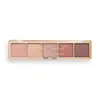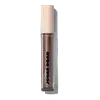What's inside
What's inside
 Key Ingredients
Key Ingredients

 Benefits
Benefits

 Concerns
Concerns

 Ingredients Side-by-side
Ingredients Side-by-side

Mica
Cosmetic ColorantTalc
AbrasiveMagnesium Stearate
Cosmetic ColorantSilica
AbrasiveHydrogenated Polyisobutene
EmollientDimethicone
EmollientPentaerythrityl Tetraisostearate
EmollientPhenoxyethanol
PreservativeCaprylyl Glycol
EmollientTriethoxycaprylylsilane
CI 77491
Cosmetic ColorantCI 77492
Cosmetic ColorantCI 77499
Cosmetic ColorantCI 77891
Cosmetic ColorantCI 77742
Cosmetic ColorantPolyethylene
AbrasivePtfe
Synthetic Fluorphlogopite
Cera Microcristallina
Emulsion StabilisingPentaerythrityl Tetracocoate
EmollientHelianthus Annuus Seed Oil
EmollientCarthamus Tinctorius Seed Oil
MaskingStyrene/Butadiene Copolymer
Tin Oxide
AbrasiveDiethylhexyl Syringylidenemalonate
Skin ProtectingCaprylic/Capric Triglyceride
MaskingCI 16035
Cosmetic ColorantCI 15850
Cosmetic ColorantMica, Talc, Magnesium Stearate, Silica, Hydrogenated Polyisobutene, Dimethicone, Pentaerythrityl Tetraisostearate, Phenoxyethanol, Caprylyl Glycol, Triethoxycaprylylsilane, CI 77491, CI 77492, CI 77499, CI 77891, CI 77742, Polyethylene, Ptfe, Synthetic Fluorphlogopite, Cera Microcristallina, Pentaerythrityl Tetracocoate, Helianthus Annuus Seed Oil, Carthamus Tinctorius Seed Oil, Styrene/Butadiene Copolymer, Tin Oxide, Diethylhexyl Syringylidenemalonate, Caprylic/Capric Triglyceride, CI 16035, CI 15850
Water
Skin ConditioningAlcohol Denat.
AntimicrobialCalcium Sodium Borosilicate
Calcium Aluminum Borosilicate
Sodium Acrylate/Sodium Acryloyldimethyl Taurate Copolymer
Emulsion StabilisingPolyurethane-4
Phenoxyethanol
PreservativeSilica
AbrasiveButylene Glycol
HumectantPolyisobutene
Synthetic Fluorphlogopite
1,2-Hexanediol
Skin ConditioningAcrylates/C10-30 Alkyl Acrylate Crosspolymer
Emulsion StabilisingCaprylyl/Capryl Glucoside
CleansingTin Oxide
AbrasiveCaprylhydroxamic Acid
Glycerin
HumectantArginine
MaskingT-Butyl Alcohol
PerfumingDenatonium Benzoate
MaskingCI 77891
Cosmetic ColorantMica
Cosmetic ColorantCI 77499
Cosmetic ColorantWater, Alcohol Denat., Calcium Sodium Borosilicate, Calcium Aluminum Borosilicate, Sodium Acrylate/Sodium Acryloyldimethyl Taurate Copolymer, Polyurethane-4, Phenoxyethanol, Silica, Butylene Glycol, Polyisobutene, Synthetic Fluorphlogopite, 1,2-Hexanediol, Acrylates/C10-30 Alkyl Acrylate Crosspolymer, Caprylyl/Capryl Glucoside, Tin Oxide, Caprylhydroxamic Acid, Glycerin, Arginine, T-Butyl Alcohol, Denatonium Benzoate, CI 77891, Mica, CI 77499
Ingredients Explained
These ingredients are found in both products.
Ingredients higher up in an ingredient list are typically present in a larger amount.
Ci 77499 is also hydrated iron III oxide. It is created from mixing red and black iron oxides. This helps give shades of darkness to a product.
Iron III oxides are classified as inorganic chemicals for coloring.
Ci 77891 is a white pigment from Titanium dioxide. It is naturally found in minerals such as rutile and ilmenite.
It's main function is to add a white color to cosmetics. It can also be mixed with other colors to create different shades.
Ci 77891 is commonly found in sunscreens due to its ability to block UV rays.
Learn more about CI 77891Mica is a naturally occurring mineral used to add shimmer and color in cosmetics. It can also help improve the texture of a product or give it an opaque, white/silver color.
Serecite is the name for very fine but ragged grains of mica.
This ingredient is often coated with metal oxides like titanium dioxide. Trace amounts of heavy metals may be found in mica, but these metals are not harmful in our personal products.
Mica has been used since prehistoric times throughout the world. Ancient Egyptian, Indian, Greek, Roman, Aztec, and Chinese civilizations have used mica.
Learn more about MicaPhenoxyethanol is a preservative that has germicide, antimicrobial, and aromatic properties. Studies show that phenoxyethanol can prevent microbial growth. By itself, it has a scent that is similar to that of a rose.
It's often used in formulations along with Caprylyl Glycol to preserve the shelf life of products.
Silica, also known as silicon dioxide, is a naturally occurring mineral. It is used as a fine, spherical, and porous powder in cosmetics.
Though it has exfoliant properties, the function of silica varies depending on the product.
The unique structure of silica enhances the spreadability and adds smoothness, making it a great texture enhancer.
It is also used as an active carrier, emulsifier, and mattifier due to its ability to absorb excess oil.
In some products, tiny microneedles called spicules are made from silica or hydrolyzed sponge. When you rub them in, they lightly polish away dead skin layers and enhance the penetration of active ingredients.
Learn more about SilicaSynthetic Fluorphlogopite is the synthethic version of mica. It consists of fluorine, aluminum and silicate.
Synthetic Fluorphlogopite is used to add volume to products.
It is considered non-irritating on the skin.
Learn more about Synthetic FluorphlogopiteTin Oxide is an inorganic oxide used to add opacity and volume to a product. In nature, it is already found in mineral form. The main ore of tin is an opaque and shiny mineral called casseterite.
Tin Oxide helps remove translucency in a product, or make it more opaque. Besides adding opacity, tin oxide is used for bulking to add volume.